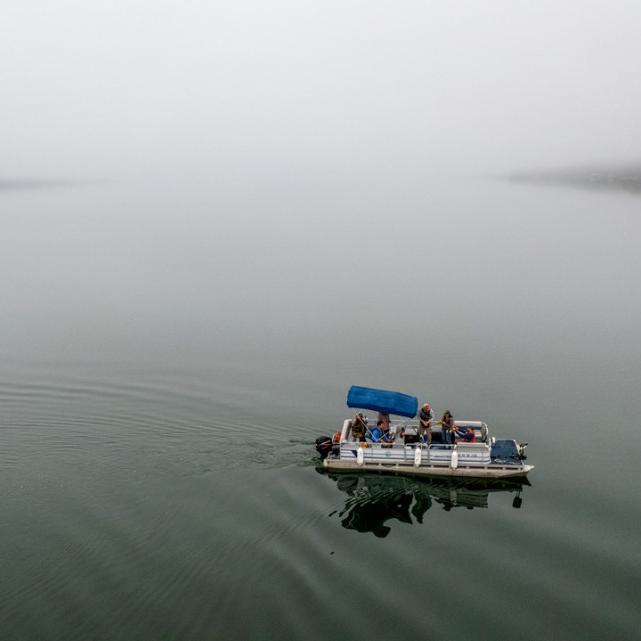A combination of ecological field methods and cutting-edge artificial intelligence has helped an interdisciplinary research group detect eelgrass wasting disease at nearly three dozen sites along a 1,700-mile stretch of the West Coast, from San Diego to southern Alaska.
The key finding: Seagrass wasting – caused by the organism Labyrinthula zosterae and detectable via lesions on the grass blades, confirmed with molecular diagnostics – is associated with warmer-than-normal water temperatures, particularly in early summer, regardless of the region. Eelgrass is a vital coastal species of seagrass for fish habitat, biodiversity, shoreline protection and carbon sequestration.
The Cornell research team – led by Carla Gomes, the Ronald C. and Antonia V. Nielsen Professor of Computing and Information Science in the Cornell Ann S. Bowers College of Computing and Information Science, and Drew Harvell, professor emeritus in the Department of Ecology and Evolutionary Biology (College of Agriculture and Life Sciences; College of Arts and Sciences) – reported their findings May 27 in Limnology and Oceanography.
Co-lead authors are Brendan Rappazzo, M.Eng. ’18, a doctoral student in computer science, and Lillian Aoki ’12, a former postdoctoral researcher in Harvell’s lab who’s now a research scientist at the University of Oregon. Ecology and evolutionary biology doctoral students Olivia Graham and Morgan Eisenlord also contributed.
Co-author J. Emmett Duffy of the Smithsonian Institution was lead investigator of a three-year, $1.3 million grant from the National Science Foundation (NSF), from which this research was born. The AI research and development was funded through an NSF Expeditions in Computing grant for computational sustainability; the initial collaboration between Harvell and the Smithsonian was developed as a Cornell Atkinson Center for Sustainability initiative.
Gomes, also director of the Institute for Computational Sustainability, and Rappazzo led the development of the Eelgrass Lesion Image Segmentation Application (EeLISA, pronounced eel-EYE-zah), an AI system that, when properly trained, can quickly analyze thousands images of seagrass leaves and distinguished diseased from healthy tissue.
How quickly does EeLISA work? According to the researchers, it works 5,000 times faster than human experts, with comparable accuracy. And as the application gets fed more information, it gets “smarter” and produces more consistent results.
“That’s really a key component,” said Rappazzo, who won an Innovative Application Award in 2021 at the AAAI Conference on Artificial Intelligence for his work on EeLISA. “If you give the same eelgrass scan to four different people to label, they’ll all give variable measurements of disease. You have all this variation, but with EeLISA, it’s not only faster but it’s consistently labeled.”
“In traditional machine learning, you need large amounts of labeled data up front,” Gomes said. “But with EeLISA, we’re getting feedback from the scientists providing the images, and the system improves very rapidly. So in the end, it doesn’t require that many labeled examples.”
This project involved a network of 32 field sites along the Pacific coast, stretching across 23 degrees of latitude. This diversity of regions allowed for the study of seagrass wasting disease in different climates and environments.
Thousands of images from the network of sites are fed into the EeLISA system, which analyzes each image, pixel by pixel, to determine whether each contains healthy tissue, diseased tissue or background. EeLISA’s initial results are scored by human annotators, and corrections are given to the software so it can learn from its mistakes.
“The researchers get their output, send their corrections back to the algorithm, and it updates the next iteration,” Rappazzo said. “The original scans for EeLISA to label, when it’s completely random, might take half an hour per scan. By the next iteration, it might be down to 10 minutes, then to two minutes, then one minute. And we reached the point where it was at human-level accuracy, and needed to be checked only sporadically.”
The AI-enabled research revealed that warm-water anomalies – regardless of what normal temperatures were for a particular region – were the key driver of eelgrass wasting disease. This told the researchers that studying the relationship between disease and climate change is necessary for all conditions, and not just in seagrass meadows in warm locations.
“We have invested a decade developing the disease recognition tools to monitor these outbreaks at a large spatial scale,” Harvell said, “because our early studies suggested eelgrass could be sensitive to warming-induced outbreaks. Eelgrass is an essential marine habitat, and a critical link in the chain of survival for fishes such as salmon and herring.”
Gomes said the goal is to scale EeLISA so it can be used worldwide for “citizen science.” Aoki said that’s one of the most interesting aspects of this work.
“We could ask people to identify seagrass disease in this much broader way, leveraging a lot more public involvement,” she said. “We’re certainly several steps away from that, but I think that is an incredibly exciting frontier.”
Other co-authors are from the University of California, Davis; the University of Alaska, Fairbanks; the University of Central Florida; the Hakai Institute, British Columbia; San Diego State University; Oregon State University; and the Mediterranean Institute for Advanced Studies, Esporles, Spain.
Support for this research came from the NSF.






